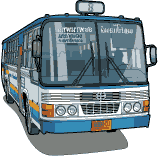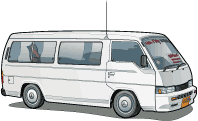Vehicle Size and Type
Road vehicles used for mass public transport range from small vehicles carrying about 10 passengers, to bi-articulated buses built to maximum permitted dimensions and weight, which may carry over 270. Each type of vehicle has a role to play, and to some extent all may be complementary to one another as part of the overall public transport system.
Vehicle size
Large buses are appropriate in certain circumstances, and small vehicles in others. It’s sometimes difficult to determine whether several small vehicles or one large one would meet the requirements of passengers and operators more efficiently in any given situation.
In broad terms, the appropriate vehicle size is influenced by:
- The volume of traffic (the number of people traveling between the same two points at the same time).
- The characteristics of the road system.
- The type of services that passengers are prepared to pay for.
Passenger flows achieved with different vehicle sizes vary considerably. A service operated exclusively by small buses with about 10 seats each can carry up to a maximum of about 3,000 passengers per hour in a single lane in one direction.
Bus capacities
Conventional buses, carrying up to 80 passengers each, can carry up to about 15,000 passengers per hour, unless there is severe traffic congestion, and more if there are exclusive bus lanes. Buses operating on busway systems can theoretically carry up to 30,000 per hour in each direction, but this figure is rarely achieved in practice.
Generally, where large numbers of passengers are to be carried so that vehicles can be filled to capacity, the most efficient and economic vehicle is the largest that can be operated legally, safely and practically within the constraints of the prevailing road conditions.
Full-sized buses can, if required, carry a high proportion of standing passengers in greater comfort than small buses, which often have very limited headroom.
Larger buses require less road space per passenger, and this can be particularly significant where road space is limited, as well as in depots, at bus stops and stations. Fewer large buses are required to carry the same number of passengers. This will normally result in lower levels of atmospheric pollution, and easier management and control, particularly of scheduling. The number of personnel required to transport a given number of passengers will also normally be lower.
Smaller vehicles are necessary on routes where road conditions inhibit the use of larger vehicles. This often applies when routes operate in high-density residential areas with very narrow streets. Other constraints on the operation of larger vehicles may include low or weak bridges, or terminals and depots with restricted access, as well as legislation restricting vehicle dimensions.
Smaller buses can provide a higher frequency of service for a given passenger flow, which can improve the convenience of the service. Passengers also often prefer small buses because they are faster and take less time to load.
Small vehicles also make it possible to offer a greater number of route variations, without adversely affecting service frequency.
Size and operating speed
The size of a vehicle can affect its operating speed in various ways. A small vehicle usually has better acceleration and maneuverability in traffic than a larger vehicle. Smaller size also means a smaller number of passengers boarding and alighting at each stop, so dwell times at stops will also be less.
Speed of operation has an effect on system capacity. A vehicle that can achieve a higher average speed will be able to provide more passenger-kilometers than a slower vehicle with the same capacity, although vehicle performance is obviously affected by prevailing traffic speeds.
Bus size and traffic congestion
Where passenger volumes are very high, the advantage of speed enjoyed by smaller vehicles is reduced or even negated by the congestion caused by large numbers of vehicles stopping simultaneously to pick up and set down passengers. In general, larger vehicles mean greater potential capacity for a transport system.
When there is a mixture of capacities on one route, different operating speeds for different vehicle sizes results in irregular service — even if buses are dispatched from terminals at regular intervals.
Except where by virtue of their numbers they are a direct cause of congestion, small buses can be advantageous in severely congested conditions. They are more maneuverable than larger buses and may cause less congestion per passenger in moving traffic than bigger buses, especially if bigger buses are not full. Similarly, where the level of traffic discipline, particularly lane discipline, is poor, smaller and more maneuverable vehicles have an advantage.
However, a very high service frequency may mean that there are often several vehicles running in convoy. This can create significant congestion compared with a single large vehicle carrying the same number of passengers.
When operated at very high frequencies small buses invariably cause more congestion at stops, by requiring more space. Small buses make wasteful use of road space. A 10-seat minibus occupies nearly three times as much road space per passenger as a full-sized bus.
Size and maintenance
Small vehicles are mass produced in greater volume than large buses, and therefore capital costs per seat or passenger-place can be significantly lower. Maintenance costs also, principally the cost of spare parts, are often lower for the same reason. Smaller vehicles are also generally easier to maintain. This makes them attractive to small private sector operators, particularly owner-drivers.
The life of a smaller vehicle is usually shorter than that of a larger vehicle, however, so depreciation costs per passenger may be relatively high. Since each bus requires a driver regardless of its size, labor costs per passenger may be higher for a small bus. But in most developing countries the difference is insignificant since wage rates are generally low. Smaller vehicles require less skill to drive, and therefore recruitment and training of drivers is easier.
Bus types
In addition to the wide range of sizes, there are various types of vehicle that may be operated on conventional bus services. Basic choices are between single and double deck vehicles, and between rigid and articulated vehicles. Within these categories there are many alternative configurations, including body and chassis layout, and mechanical specifications.
Different standards of passenger accommodation may be provided, although not normally on the same vehicle. These standards range from very basic, perhaps with the majority of passengers required to stand, to very high, with features such as air conditioning, reclining seats, video, toilets and refreshments.
It’s common, particularly on bus routes with high volumes of passenger traffic, to provide two or more standards of service, using vehicles with different specifications.
Single deck buses
Single deck buses range in length from about 5-to-12 meters. In some countries even longer buses are permissible, up to a maximum of about 15 meters, although such lengths are impractical except where operation is exclusively on roads that are relatively wide and straight. If buses longer than 12 meters are required it’s normally necessary to use articulated vehicles.
The shortest single-deckers, about 5-to-6 meters long and carrying between 10 and 20 passengers, are often referred to as minibuses, and sometimes as microbuses. They are usually designed for all passengers to be seated, although standing passengers are often carried in cramped conditions.
Buses between about 7 and 8 meters long, carrying 20-to-35 seated passengers, sometimes with accommodation for additional standing passengers, are often referred to as midibuses. Although in some countries these are also known as minibuses. Full-sized single-deck buses can carry between 60 and 120 passengers including those standing.
Double deck buses
Double deck buses, normally about 9 and 12 meters in length, but up to 15 meters in some countries and seating between 60 and 120 passengers, are operated on urban services in many countries.
Double-deck buses have a number of advantages. They are able to provide a high seating capacity within a limited space. They occupy less road, terminal and depot floor space per seated passenger. In congested traffic conditions and where space is limited this can be a major advantage.
However, the saving in space per passenger can be comparatively small depending on the proportion of standing to seated passengers that is acceptable. Where all passengers require seats, as in the case of heavily used premium-quality urban services, the double-decker offers a greater advantage than where a high proportion of standing passengers is acceptable.
Double-deckers have a number of disadvantages compared with single-deckers, including:
- Increased loading and unloading times.
- Additional costs from the more complex construction.
- A staircase is required.
- Greater headroom in depots is required.
- Low bridges and other overhead obstructions, such as utility cables, often restrict the routes where they can be used.
Articulated buses
Articulated (including bi-articulated) single deck buses, carrying up to 270 passengers and sometimes even more, are efficient movers of large numbers of passengers. They are more maneuverable than rigid buses of the same length. They can be much longer than rigid buses — up to 25 meters is possible, although the normal maximum length is approximately 18 to 20 meters.
Articulated buses can be very effective where labor is scarce or expensive, passenger volumes are high, roads are relatively wide and straight, and space is not severely restricted. With well-designed bus stop facilities and appropriate fare collection systems, they can load and unload very quickly despite their size. However, they require greater skill to drive, particularly when reversing. The number of routes that they may be used is often also limited. Specially designed depot facilities may also be required. Where congestion is severe and roads are narrow they may be impractical.
Their more complex construction makes them more expensive to purchase and maintain than rigid single-deckers or double-deckers (typically, 25% or 30% more than a double-decker), and reliability may be a problem where road conditions are poor.
Articulated buses must have good access to bus stops, with all doors accessible from the curb without obstruction from parked cars or street furniture. It’s particularly important to ensure that passenger shelters and safety barriers are positioned so that they do not obstruct any of the doors of buses using the stop.
